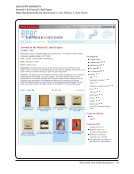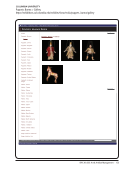SPEC Kit 333: Art &Artifact Management · 83
National Library of Medicine
Collection Development Policy. Images and Archives Section
Collection Development Policy—Images and Archives -5 -
2. Leaders in medicine outside the disciplines above.
3. Professional medical societies.
Special Considerations for Individual Programs
Archives and Modern Manuscripts
The following types of collections are preferred, in rank order:
1. Personal papers.
2. Oral/video histories.
3. Bound/folio manuscripts.
4. Closed institutional records, where the collection is no longer growing.
5. Open, active, and growing institutional records.
Justification:
The social and cultural history of health and medicine is most effectively told through the
personal papers, oral histories, and video histories of significant figures.
Our bound and folio collection is slowly growing, mostly through purchase. These are often
individually significant items, and usually build to the strength in the collection, especially
recipe books, herbals, etc.
Institutional records can be a good source for history, but need to be carefully evaluated, as
often the “density” of materials is not high, with a great proportion of records devoted to
routine society business or society publications. Open, active, and growing institutional
records usually represent a significant investment of time and resources to ensure continued
deposit of materials with the Library, and need to be carefully assessed before this
relationship is agreed to.
Prints and Photographs
The following types of collections are preferred, in rank order:
1. Post-1950 “genre” shots, that is, pictures of health and medicine activities, rather
than stock portrait or institutional shots.
2. Selective continuation of portraiture and institutional materials, especially post-1950.
3. Public health and quackery materials, especially including posters, ephemera,
advertising materials, as discussed above.
4. Special emphasis on international efforts and on efforts involving women and
minorities.
National Library of Medicine
Collection Development Policy. Images and Archives Section
Collection Development Policy—Images and Archives -5 -
2. Leaders in medicine outside the disciplines above.
3. Professional medical societies.
Special Considerations for Individual Programs
Archives and Modern Manuscripts
The following types of collections are preferred, in rank order:
1. Personal papers.
2. Oral/video histories.
3. Bound/folio manuscripts.
4. Closed institutional records, where the collection is no longer growing.
5. Open, active, and growing institutional records.
Justification:
The social and cultural history of health and medicine is most effectively told through the
personal papers, oral histories, and video histories of significant figures.
Our bound and folio collection is slowly growing, mostly through purchase. These are often
individually significant items, and usually build to the strength in the collection, especially
recipe books, herbals, etc.
Institutional records can be a good source for history, but need to be carefully evaluated, as
often the “density” of materials is not high, with a great proportion of records devoted to
routine society business or society publications. Open, active, and growing institutional
records usually represent a significant investment of time and resources to ensure continued
deposit of materials with the Library, and need to be carefully assessed before this
relationship is agreed to.
Prints and Photographs
The following types of collections are preferred, in rank order:
1. Post-1950 “genre” shots, that is, pictures of health and medicine activities, rather
than stock portrait or institutional shots.
2. Selective continuation of portraiture and institutional materials, especially post-1950.
3. Public health and quackery materials, especially including posters, ephemera,
advertising materials, as discussed above.
4. Special emphasis on international efforts and on efforts involving women and
minorities.


















































































































































































